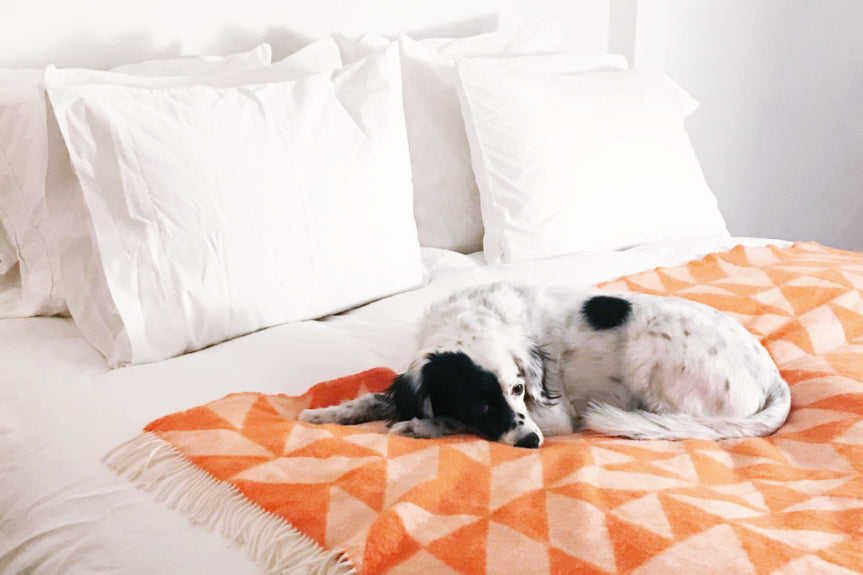How to Care for Cotton and Linen Sheets

We spend about a third of our day in between sheets, so it's a good idea to invest in a comfortable material and launder in a way that supports the material's longevity.
First, and most importantly, we recommend washing with products that won't hinder fiber breathability and drying on low temperatures whenever possible.
Read on for FAQ we've received about sheet care:
☁️ Does it matter what kind of sheets I choose?
Absolutely. Always check the label and care instructions before buying. Your everyday sheets should be easy to care for and the material should be able to withstand warm or hot washes for hygienic reasons. If this isn’t the case, it’s probably best to choose a different set of sheets.
☁️ How often should I be washing my sheets?
You should wash your sheets at least once a week. If someone is sick in bed or prone to accidents (e.g. potty training kiddos or pets), you’ll want to wash your sheets more frequently, and as soon as possible after any accidents. 🐶
☁️ Can I wash my cotton sheets with cold water?
Without accidents or sickness, you can get away with washing your sheets in cold water (this saves energy). If you like, add ¼ cup of distilled white vinegar to the fabric softener compartment to help flush out odor during the rinse cycle. If you’re washing with cold water most of the time, try to do a warm or hot cycle at least once a month.
☁️ How should I dry my sheets?
Dry your cotton sheets on low heat for longevity. We suggest adding a few dryer balls to reduce static cling and shorten the dry time, too.

☁️ What about linen sheets?
Linen sheets can be washed on cold and dried on low to minimize shrinkage. We also like adding a ¼ cup of white vinegar to the washer’s fabric softener compartment and dryer balls to the dryer for softness.
Linen has a lived-in look and appears naturally wrinkly. If you prefer a smoother look, use a steamer or warm iron on your linen sheets.
☁️ How much detergent should I use?
Not a lot! You might even be able to use less than what’s recommended if you have an efficient home washer or use industrial washers at a laundromat or shared laundry space.
It’s really common for people to use too much detergent and many of us do it without even realizing. Don’t let the scoop or cup run over, especially if the load you’re washing isn’t heavily soiled. Excess detergent that doesn’t wash out will hinder the fibers’ ability to give you a comfortable night’s sleep.
While we're on the topic of detergent: Choosing a good detergent is really important. Don’t let your skin—your largest organ—absorb phthalates, phosphates, formaldehyde, chlorine, SLES or dioxane. Avoid fabric softener, which contains synthetic fragrance and is designed to coat fabric (hinders breathability).

☁️ Can I bleach my white sheets?
We’re big proponents of not using chlorine bleach. It’s harsh on fabric, which isn’t good for longevity and can contribute to yellowing overtime. Not to mention, it’s corrosive and can irritate or burn your eyes, skin and lungs.
Instead, we recommend using an oxygen booster to keep white sheets looking bright. There are a number of options available on the market—ours is called Supersalt, made of sodium percarbonate and washing soda.
☁️ What if there are bloodstains?
Rinse with cool water as soon as you find any bloodstains. If you act quickly, the water should get most of the blood out. If the stain needs coaxing, use Supersalt to spot treat: Start by adding a little water to the powder to create a paste, then work that paste into the stain with an old toothbrush.
If the stain covers a large area, you can pre-soak the sheets overnight with some Supersalt dissolved in warm water, and machine wash the next day.
☁️ Can I use baking soda?
Baking soda (sodium bicarbonate) is great at removing odors and softening; it also has some bleaching properties. That said, a more effective way of blasting bloodstains is using an oxygen product (sodium percarbonate). Sodium percarbonate works by releasing oxygen once it’s exposed to water. This release of oxygen lifts stains and dirt off whatever you're cleaning.
If you don’t have access to a Supersalt or another oxygen booster, you can also try hydrogen peroxide. Cover the stained area with hydrogen peroxide and blot with a clean towel, then machine wash. Don’t forget to test a small patch in a discreet area for color fastness if your sheets aren’t white.
☁️ What else should I know about treating stains on sheets?
Don’t wash and dry as normal without first tending to the stain. If the your stain doesn’t come out in the wash and your sheets go into the dryer, that’s likely going to set your stain. You’ll have a really hard time getting rid of your stain once it has set.
**
Tips by Mutia Adisoma, Corinna & Theresa Williams
Photo of Georgie the dog by Meghan Folsom
Photos of West Elm bedding by Landon Vonderschmidt (location: Celsious)
